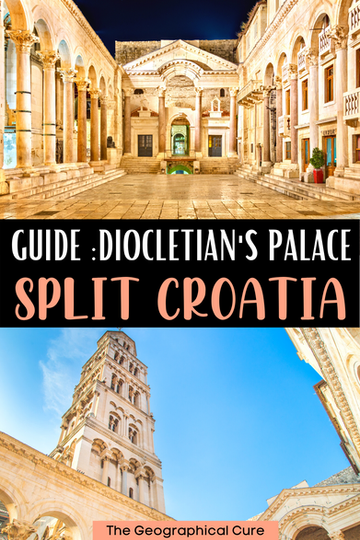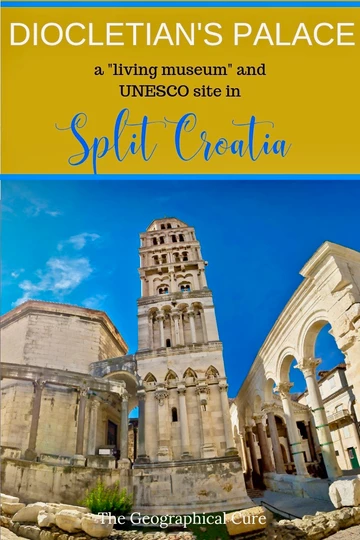Here’s my guide to visiting the magnificent Diocletian’s Palace in Split Croatia. It’s one of the most impressive and well preserved Roman ruins in Europe and the top must visit attraction in Split.
With a fetching location on the dramatic Split harbor, Diocletian’s Palace is one of the most imposing ancient Roman structures in existence today. It’s not just a palace, or a museum, or a UNESCO site. It is the living, breathing, vibrant heart of Split.
READ: Guide To Roman Ruins in Rome
The 4th century complex is a sprawling maze of beautifully preserved ancient ruins, shops, restaurants, apartments, and people. It’s a delightful confluence of ancient history and modern life, happily commingled as a “living museum.”
And like a reclining Roman Emperor, it beckons you inside.
Life of the Emperor Diocletian
The Emperor Diocletian was born in Salona Croatia, 6 miles outside Split, in 244 AD. Split was then part of the Roman Empire. From humble origins, Diocletian rose through the ranks of the military and became a cavalry commander. In 284 A.D., Diocletian succeeded as Emperor at age 39.
He restored efficient government to an empire in near anarchy. In 293 A.D., he restructured the government in Rome by establishing a Tetrarchy, a system of rule in which four men shared power over the sprawling Roman Empire. The four tetrarchs based themselves not in Rome but in cities that served as defensive headquarters against bordering enemies.
READ: 3 Day Itinerary for Rome
Diocletian is best known, however, for the Diocletianic Persecution — the Roman Empire’s last, largest, and bloodiest persecution of Christians. Diocletian viewed Christians as a threat, during an unstable time, to traditional Roman values. To attempt to eradicate the pesky religion, Diocletian torched churches, burned scriptures, arrested clergy, and tortured and murdered Christians.
It didn’t work. In 324 A.D., the Emperor Constantine signed a religious tolerance edict protecting Christians. He later converted to Christianity on his deathbed.
Despite his bureaucratic bent, Diocletian was a colorful man with a big ego. He thought he was a living god.
In his palace, he was regularly celebrated as the living son of Jupiter. His subjects would prostrate themselves before him, kiss the hem of his robe, or fall on the floor before him. To amplify the effect, Diocletian often wore a jeweled diadem and sat upon a magnificent, elevated throne.
When he fell seriously ill, Diocletian abdicated in 305 A.D. He became a cabbage gardener, a passion he apparently took quite seriously.
As an elder statesman, Diocletian fended off entreaties to return to office, saying: “If you could show the cabbage that I planted with my own hands to your emperor, he definitely wouldn’t dare suggest that I replace the peace and happiness of this place with the storms of a never-satisfied greed.”
The History of Diocletian’s Palace
Having just arrived in Split from Dubrovnik, my daughter and I immediately embarked on a 90 walking tour of the palace at night.
Since there isn’t much signage, the tour was invaluable to understand the site. You will miss details if you begin your visit aimlessly wandering, though aimless wandering is a fantastic post-tour activity.
Diocletian’s Palace was listed as a UNESCO World Heritage site in 1979. The Split tourist board describes the palace as:
one of the best preserved monuments of the Roman architecture in the world. The Emperor’s Palace was built as a combination of a luxury villa – summer house and a Roman military camp (castrum), divided into four parts with two main streets.
Diocletian began building his city-sized masterpiece in 300 A.D. No expense was spared.
The palace took approximately 10 years to complete. It was made of lustrous white limestone from the island of Brač. The whole complex occupied 30,000 meters.
The palace was meant to be Diocletian’s seaside retirement home. Half the palace was intended for his personal use, the other half housed a military garrison. As a result, the structure is quite fortress-like with its four massive walls and heavily fortified gates.
In 305 A.D., Diocletian fell ill and voluntarily gave up the throne. He was the only Roman Emperor to ever cede the title. He lived in the palace until his death in 311 AD, at the age of 66, and was interred in its Mausoleum.
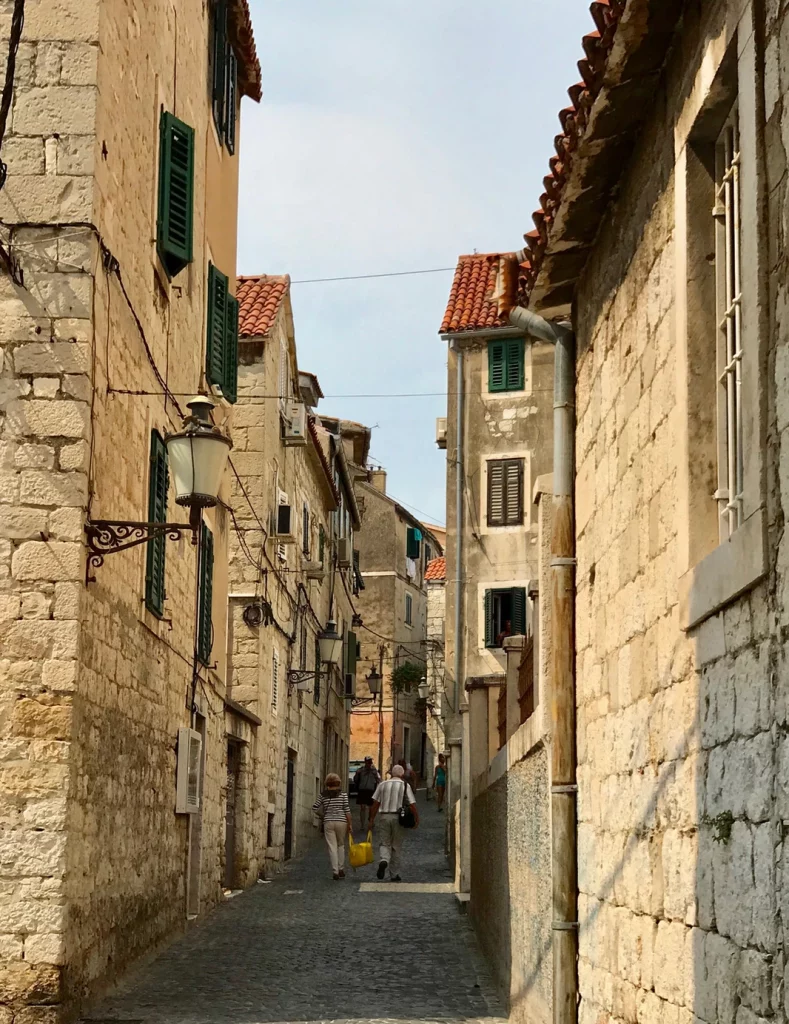
narrow streets of Diocletian’s Palace 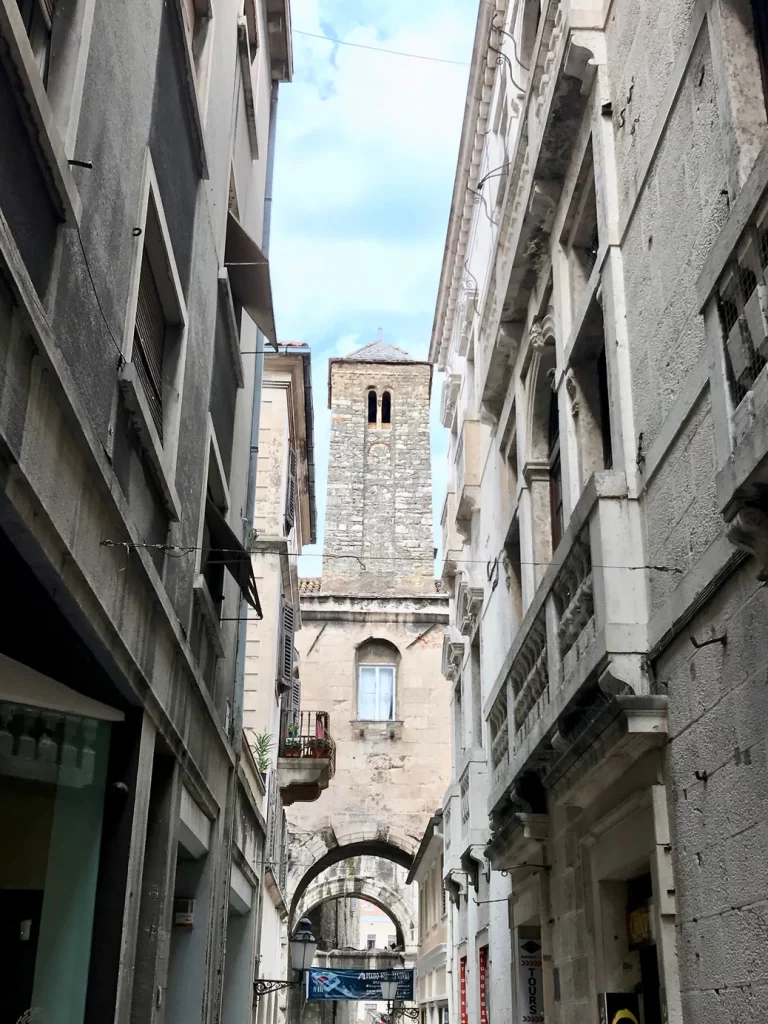
narrow streets of Diocletian’s Palace 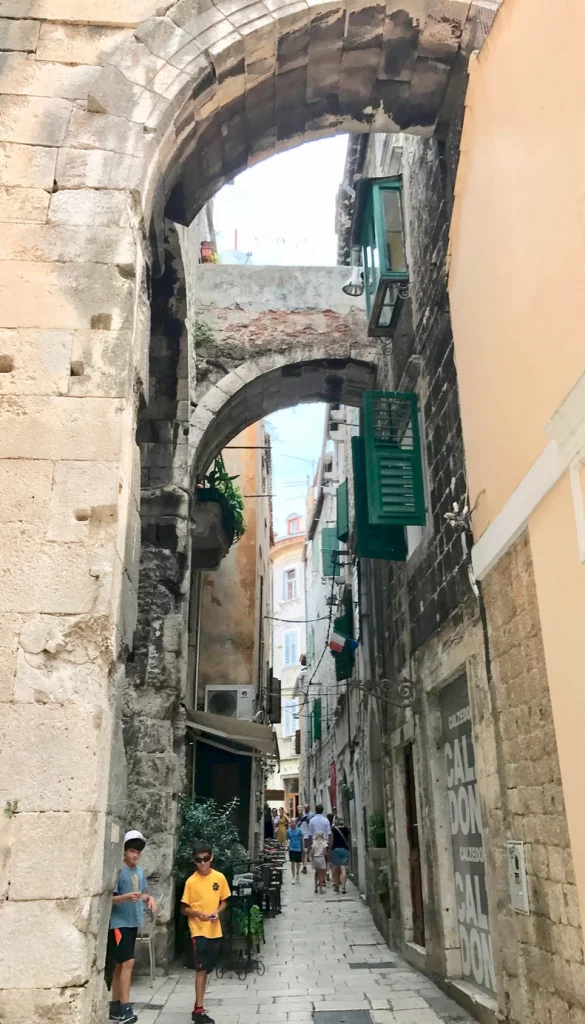
narrow streets of Diocletian’s Palace
An Abandoned Palace
150 years after Diocletian’s death, the Roman Empire fell and Diocletian’s Palace was abandoned, withering beneath the Mediterranean sun.
It remained empty until the 7th century when Dalmatians fled into the walled palace to escape invading Slavs. They created houses and businesses within the walls and transformed the palace into a town. Most structures were repurposed. Gothic and Renaissance elements were added. The residents moved in and they never left.
To this day, approximately 3,000 people live within the hodgepodge of the palace walls. Amid the temples, you’ll see laundry hung out to dry, parked scooters, vendors selling garlic and prosciutto, and plants being watered. There is a maze of streets, which have once again been repurposed with restaurants and trendy boutiques.
As a result of constant recycling, Diocletian’s Palace is essentially a multi-phase “living museum.” People live, work, and eat in the UNESCO site. It is the only currently inhabited roman ruin. Its survival and reuse of historic elements tell a valuable tale of sustainability.
What To See At Diocletian’s Palace
1. The Palace’s Central Square: the Peristyle
The peristyle was the Palace’s central square, where powerful Roman citizens gathered or came to worship Diocletian. It is one of the best preserved parts of the Palace, an open rectangular court decorated with a colonnade.
The darker columns, representing imperial power, were shipped from Egypt. The Peristyle’s imported black granite sphinx dates back 3500 years.
The Peristyle was cleaned and restored between 2001-10, with centuries worth of dust and grime removed. Today, it gleams.
At noon each day in summer, Croatian students dressed as Roman centurions perform an elaborate reenactment of the Roman changing of the guards. Diocletian and his wife Priska, dressed in flowing gowns and flanked by their Praetorian Guard, greet the crowds.
Diocletian gives a short speech in Latin and English inviting everyone to visit his palace. This is a popular tourist attraction in and of itself.
The Peristyle is lit up at night, and is quite a sight. A fantastic mix of locals and tourists frequent the square, often listening to live music or street theater.
2. Vestibule
Just off the Peristyle is the Vestibule. This circular room is visually interesting and has impeccable acoustics.
This was not an accident, but a crafty move. Emperor Diocletian’s bedroom lay directly above the vestibule and the acoustics meant he could hear the approach of possible assailants. He was justifiably paranoid about being murdered (many Roman Emperors were whacked). But, in fact, he was the only emperor to die of natural causes.
When we were there, in August, there was an acapella group taking advantage of the acoustics.
The opening, or oculus, was intended as a window between heaven and earth through which the gods could look down upon Diocletian. It was likely modeled after the Pantheon in Rome.
3. Cathedral of Saint Dominus
The cathedral was originally Diocletian’s Mausoleum. It was built in 305 A.D, and Diocletian was interred there after his death in 311 A.D. The Mausoleum was deliberately located to face the Temple of Jupiter, Diocletian’s patron god.
In the 5th century, however, the Christians got the last laugh. In an understandable pique, they destroyed the emperor’s sarcophagus and converted his tomb into a cathedral. To top it off, the cathedral is dedicated to one of the victims Diocletian decapitated in the city’s amphitheater.
It’s considered the oldest cathedral in the world. It has all the usual churchy things in pristine condition — a choir, a gilded and carved altar, octagonal pulpit, murals, and reliquaries. It also has a perfectly preserved dome, one of the widest (44 feet) Roman domes in existence.
One of the cathedral’s finest flourishes is its massive wooden entry doors. They feature 26 carved Romanesque miniatures protected by glass.
The cathedral’s crypt is accessed by an exterior door on the right side of the church. It is now a shrine for St. Lucia, also martyred by Diocletian.
4. Bell Tower
The tall Romanesque bell tower was constructed between the 13-16th centuries. The climb is not for those with a fear of heights.
Part of the way, you’ll be on flimsy metal step suspended over a void. But the climb is well worth it. You’ll have tremendous 360 panoramic views of Split.
Unfortunately, the Bell Tower is currently closed for renovation for the next 2-3 years.
5. Temple of Jupiter
Diocletian’s Temple of Jupiter, dates from approximately 295 to 305 A.D. It is a small building located near the Peristyle.
The vengeful Christians didn’t spare this temple either. They beheaded the Egyptian Sphinx that guards the temple’s entrance because it was a pagan symbol.
In the 6th century, the temple was converted into a baptistery dedicated to St. John.
Upon entering the temple, stop for a minute or two to explore the relief above the door. It’s made of white limestone which was quarried on the nearby Island of Brač.
The barrel vaulted ceiling consisting of 64 individual panels is also a stunner. Each panel has intricately decorated sides and a face or mask representing a particular emotion in the center.
It’s unclear why masks were placed on the temple’s ceiling. Possibly, they derive from religious rituals or are an artistic representation of the eccentric emperor’s moods.
There is also a modern bronze statue of St. John the Baptist created by Croatia’s most famous sculptor, Ivan Meštrović. He also created the massive sculpture of Gregory of Nin that stands outside the Golden Gate.
6. Palace Gates
The gates of the palace contain some of the most impressive ruins. There were once four gates, named after four metals: gold, silver, iron, and bronze.
The Golden Gate (north side), pictured above, was the monumental entrance that Diocletian first used in 305 A.D. It could only be accessed by him and his family.
The niches used to contain statues of the four tetrarchs who governed the Roman Empire. The Golden Gate is now the main gate of the palace.
The Silver Gate is on the east side. In the 1950s, it was unearthed to its original level and restored to its original appearance.
Remains of the octagonal towers are still visible. In 2000, Pope John Paul II passed through the Silver Gate on his way to pray in Saint Dominus Cathedral.
The Iron Gate (west side) was our favorite. It has a tiny church with a beautiful Romanesque bell tower right above the door.
The Bronze Gate (south side) is very small and simple. It led from the living quarters to the sea, providing an escape route if there was a mainland attack. This is the gate where most tourists start their guided tours.
7. Palace Cellars
The cellars are accessed from the Bronze Gate or the downward steps from the Peristyle. They are vast and maze-like. In Diocletian’s time, they were used for wine storage and later for debris. The cellars were excavated and renovated in the 1850s.
The cellars layout gives you an indication of the layout of the imperial apartments, which were located on the floor above and were destroyed.
Nowadays, the main hall of the basement houses souvenir shops.
8. The Roman Baths
At the basement level, you will also find the ruins of Diocletian’s Baths, the only part of the royal residence remaining. Romans, of course, are known for loving their bath houses, and Diocletian was no exception.
Purportedly, one reason Diocletian chose Split is that the town was renowned as a source of sulfur. He suffered from arthritis and gout and soaking in the sulfurous water helped sooth his ailments. Some of the mosaics from the bath are actually still visible.
Diocletian also built baths in Rome, which are one of Rome’s hidden gems.
Game of Thrones: Here Be Dragons in Diocletian’s Palace
Diocletian’s Palace is featured in Seasons 4 and 5 of HBO’s hit series Game of Thrones. The palace’s narrow streets are the site for a bloody battle between the Sons of the Harpy and Daenerys Targaryen’s Unsullied army.
The cellars serve as Daenerys’ throne room in Mereen. They are also dragon daycare for her dragons Viserion and Rhaegal, who were chained there for months because she feared their growing wildness and aggression.
After the murder of key advisors and her Unsullied warriors, Daenerys rounds up the heads of the prominent houses in Meereen to put the rebellion to rest. As punishment, she has one of her cellar bound dragons scorch one to death.
After you’re done with dragons and Diocletian, wander around Split. It’s a lovely, laid back, limestone heaven.
Or take a stroll on the Riva, the seaside promenade of Split, a pedestrian haven of cafes and restaurants.
READ: Best Things To Do and See in Split Croatia
Practical Information for Diocletian’s Palace:
Address: Dioklecijanova ul. 1, 21000, Split, Croatia
Hours: The Peristyle is always open to the public. Hours for Saint Dominus Cathedral are Monday through Saturday from 8 a.m. to 7 p.m. and Sundays from 12:30 to 6:30 p.m. Or, you can experience this working Catholic church for free during Sunday Mass.
Entry: There is a 45 Kuna (about 6 USD) combined ticket at the entrance of the Cathedral. This will give you access to the Cathedral, the Crypt, the Treasury, and Jupiter’s Temple. The Bell Tower is currently closed for 2-3 years.
Tel: +385 21 345 602
If you’d like to visit Diocletians’s Palace in Split Croatia, pin it for later!

